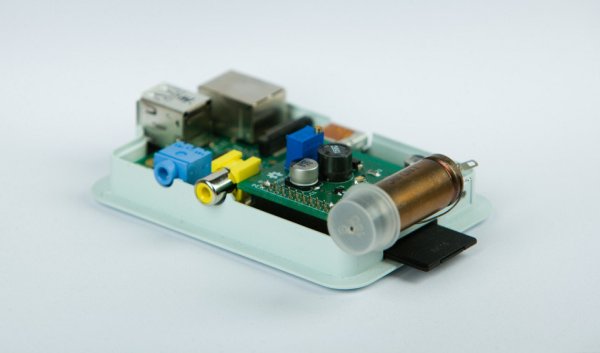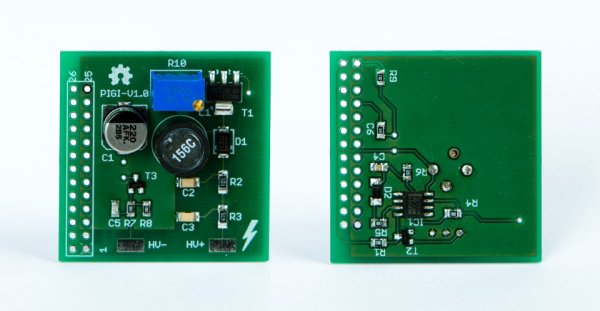Geiger counters are basically just devices which enable us to measure ionizing radiation. In the context of human activity we have to deal with natural radiation sources and artificial ones. Some of the materials emitting ionizing radiation are used to create electricity, others were used to stockpile thermonuclear bombs, so many could get scared and a few could get rich. But how do we deal with some thing we cannot actually see, hear, feel, smell or taste? Exactly! We just don't think about it. We never perceive it as potentially dangerous to our health until an accident happens and someone with a geiger-counter we have to trust can tell us how sunny the “weather” is.
That should be in common rational awareness instead of ignorance or fear. Just like rain. We all know rain is neither good nor bad. It's just rain. And when we stay out too long in the rain without the appropriate protective clothing, we might get soaked so bad, that we might get sick. Our brain determines our maximum allowed in-rain time and the level of protective gear we need to repel the rain so we just visually perceive how many rain drops we see and how big they are. That gives us the freedom to decide whether to stay indoors or to wear some form of raincoat or just to risk it.
Unfortunately our body won't help us with detecting ionizing radiation (although it can suffer badly from it) but that's where geiger counters come back in: They let us “see” the radiation levels and therefore give us the freedom to decide if and how we want to go on.
After the recent nuclear disaster at the Fukushima Daiichi nuclear power plant in Japan a lot of people started to realize this and began to develop, build and buy geiger counters and geiger counter kits. Many share their local radiation levels through social networks and simple maps, just like a rain radar (e.g http://blog.safecast.org).
This would also be a great metric to collect for Argus and to display the data as an overlay in DSpace. Now imagine hundreds of these cheap solutions spread all over the world and sharing the metrics with one another to get a global Open Radiation Monitoring (ORM) network.
PiGI Module
The Raspberry Pi is a perfect platform to be a cheap but very versatile geiger counter. It can be connected to a TV/Monitor to display a nice graphical interface, it can play the nostalgic tak, tak, taktaktak sound via audio output and it can also serve as an autonomous geiger counter sensor node (even solar powered) collecting and sharing real-time and historic data. All you need is:
-
A Raspberry Pi
-
PiGI Module
-
Geiger-Müller Tube
The PiGI is designed & built as a simple open-source plug and play module for the Raspberry Pi to transform it into a cheap and hackable multi purpose geiger counter. It generates the necessary high voltage (up to 1000V) the GM tubes require to operate (typically 400-600V for beta/gamma GMTs).
Some pancake sensors (mostly used for alpha radiation) require an even higher voltage, theoretically the circuit should cover it. However, that's untested, only a LND712 (new, see picture) and two old Phillips tubes (Frieseke&Hoepfner FHZ74/76) could be tested, due to limited prototyping resources.
For every impulse the geiger tube registers the PiGI pulls a GPIO Pin of the Pi to ground (falling edge detection). On the Pi runs just a little daemon called counterd which waits for an interrupt to register the count and notify the display/audio/data-storage/network handler. That's why it can also easily be connected to any other embedded/micro controller system like:
-
Arduinos
-
ATMegas
-
PICs
-
Spark-Cores
-
Other embedded Linux ARM/MIPS systems with GPIO Inputs (Netus G20 etc.)
HOWTOs can/will be provided, drop a comment if you need one for connections/pull-up configuration.
Use Cases
-
Local/Handheld Alpha/Beta/Gamma Radiation Measuring
-
Radioactive Decay based Hardware Random Number Generator
Specifications
| Board Dimensions | 40x43mm |
| Output Voltage | Up to 1000V |
| Current | <2mA @ ~0.09uSv/h local dose rate |
-
Efficient design – very low energy consumption – supplied by the Pi
-
Simple circuit / Low BOM count
-
Simple layout for easy hand-soldering (even for SMT beginners)
-
Dual layer (top/bottom) only 3 vias – for easy DIY replication
-
Very cheap design (Prototype costs per Module: <EUR15)
-
Dual stackable for low/high dosis counting with 2 tubes
-
Micro controller input protection (impulse inverter)
-
Free & Open licencing: CERN OHL 1.1
-
Plug and Play for Raspberry Pi
Hardware
If you want to know more about the design or want to build one yourself, check out the PiGI Hardware Section for a detailed circuit description, schematics and printed circuit board layouts.
Software
We've invested a couple of days into the new geiger counter software. Even though it is only in an early rough state it is already fun to work with. It's implemented as a full mobile-first HTML5/CSS3 Websocket based web application, than can be used in latest chromium & firefox browser. You can learn more about it in the software section
Implemented features
-
Live Status
-
Live (15min/60min/24h) Graphs
-
Analog gauge
-
Ion Trace Visualizer
-
History
-
Tick Simulator (For show and development)
-
Hardware RNG entropy generator
Status / History
| 2013-04-15 | Project Idea |
| 2013-04-17 | Basic circuit definitions |
| 2013-04-23 | Identified and ordered all parts |
| 2013-04-28 | Finished V1.0 Prototype Layout |
| 2013-04-30 | Ordered 7 prototype boards from MultiPCB |
| 2013-05-05 | Soldered first prototype |
| 2013-05-13 | Added dual-stack option (V1.1) |
| 2013-05-19 | Changed R1 from 3k9 to 1k to make T1 work more reliable |
| 2013-05-22 | Bumped prototype layout to V1.1 for production release |
| 2013-05-23 | Started long-term stability test |
| 2013-06-17 | Stopped long-term test for live-demo (stable/reliable 100% until now) |
| 2013-06-17 | 2nd prototype board finished |
| 2013-06-23 | Updated + Added V1.0 board images |
| 2013-07-25 | Pre-production planning |
| 2013-08-04 | Indiegogo.com campaign drafting has begun |
| 2013-08-09 | Selected CERN OHL 1.1 as licence for now |
| 2014-02-08 | Personal Log: PiGI Testing |
| 2014-03-04 | PiGI Software Hacking & Hackathon |
| 2014-06-13 | Generating Entropy From Radioactive Decay With PiGI |
| 2014-06-28 | More PiGI prototype boards finished |
| 2014-10-15 | Added PiGI Longterm Test Data to VFCC Dashboard (ORM Precursor) |
Next steps:
-
Run a crowd funding campaign
-
Get adafruit or seeedstudio to produce, sell & ship PiGI's for a fair price (You could help by sending them a note with your interest and link to this page, so that they know there is demand)
For more detail: PiGI – Raspberry Pi Geiger-Müller Interface



